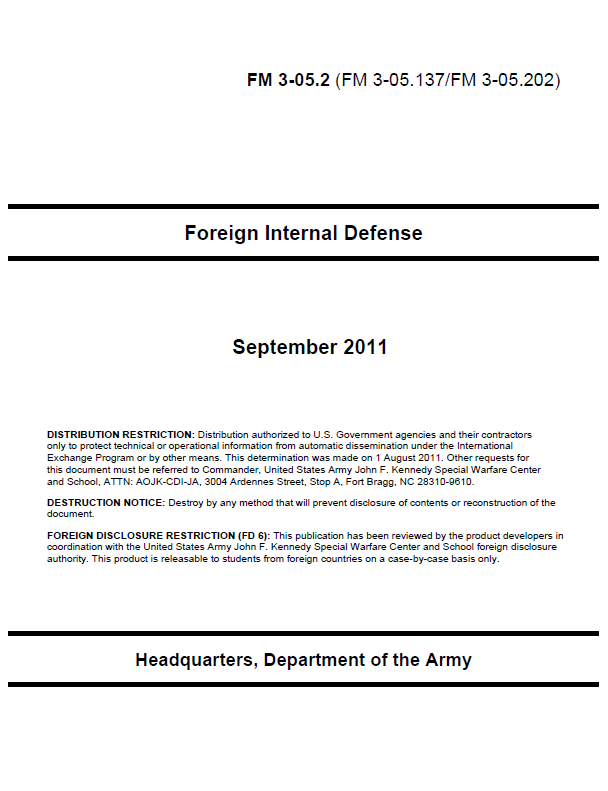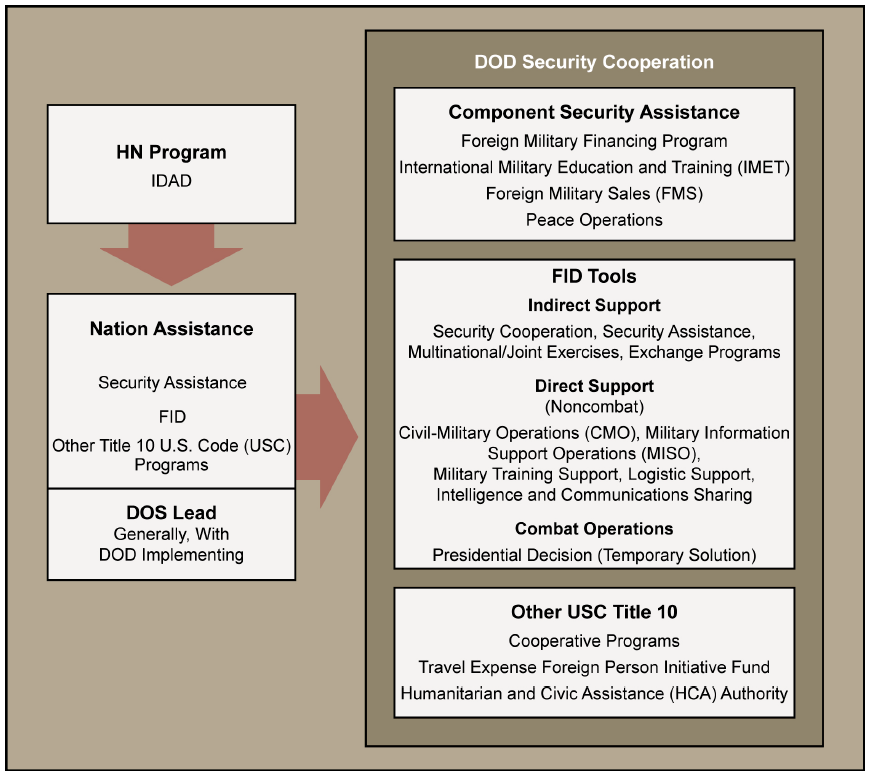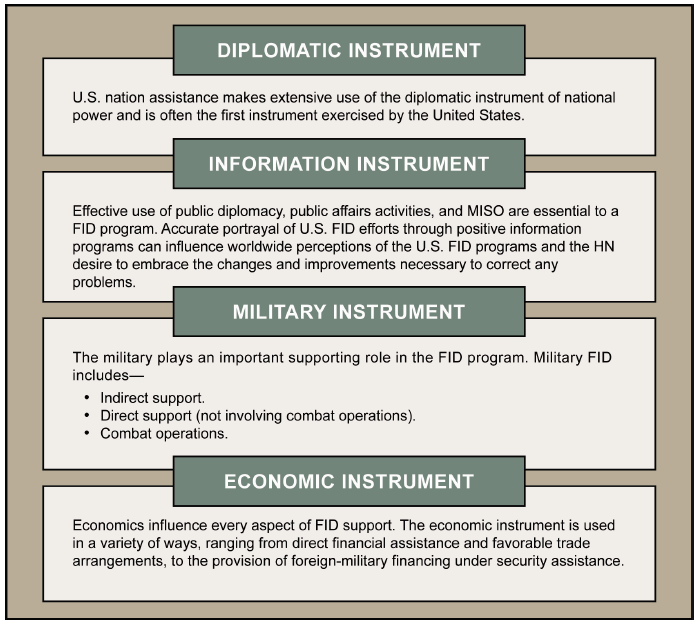FID is participation by civilian and military agencies of a government in any of the action programs taken by another government or other designated organization to free and protect its society from subversion, lawlessness, insurgency, terrorism, and other threats to its security (Joint Publication [JP] 3-22, Foreign Internal Defense). This publication depicts the integrated theater efforts that include ARSOF and conventional forces roles in joint, multinational, intergovernmental, and nongovernmental organizations working in a collaborative environment. It provides an overview of selected sources of power applied through the instruments of national power brought to bear for supporting FID and the impact and interaction of Army units with the other instruments of national power. In addition, it illustrates how FID is a key component of a host nation’s (HN’s) program of internal defense and development (IDAD), and that the focus of all U.S. FID efforts is to support that IDAD program to build capability and capacity to free and protect the HN from subversion, lawlessness, and insurgency.
…
1-1. The Army may conduct FID operations unilaterally in the absence of any other military effort or may support other ongoing military or civilian assistance efforts. The National Security Strategy of the United States (2010) establishes that the United States (U.S.) military will continue strengthening its capacity to partner with foreign counterparts, to train and help security forces, and to pursue military-to-military ties with a broad range of governments. U.S. policy currently deals with these threats through the indirect use of military force in concert with the diplomatic, informational, military, and economic instruments of national power. FID may include financial, intelligence, and law enforcement assistance authorized by the Department of State (DOS) and administered by the DOD. This approach relies on supporting the efforts of the government of the nation in which the problem develops. Army forces are qualified to operate in a FID operation that takes place under a regional or global media and political microscope. Culturally and politically attuned ARSOF Soldiers know that in the contemporary environment, the smallest misstep (or perceived misstep) in any arena can quickly expand into an international political media spectacle. In addition, ARSOF Soldiers, who are trained in the HN language and culture, are cross-trained on the culture and history of their unit’s aligned region. Therefore, ARSOF Soldiers are uniquely qualified to advise their HN counterparts and trainees on how best to approach regional or transnational rivalries or how to deal with outside pressures from potential transnational spoilers. Conventional force units conducting FID may require specific training for not only the local culture but also for the inherent political pitfalls of tactical operations having regional, transnational, or international implications. Planners must be mindful that all FID operations, to include small contingents have the potential to move quickly from obscurity to the center stage of global media. Planners must also keep in mind that regional issues (and beyond) can be mitigated if properly identified.
1-2. The key differentiating factor between FID and many other operations is the involvement, engagement, and support of the HN government. Historically, because of some similarities between the TTP used to conduct FID and those used to conduct other ARSOF core activities, there has been confusion and incorrect usage of the term. FID involves the support of a standing government and its lawful military and paramilitary forces. FID is usually conducted in HNs in which the embassy Country Team is not only present, but is also frequently the lead agency in the operation. The American Embassy Country Team develops measures to promote security in conjunction with the HN through the development of a yearly theater security cooperation plan (TSCP). The TSCP is what links the geographic combatant commander’s (GCC’s) regional strategy to military operations. The Country Team coordinates synchronization of military operations with interagency initiatives and activities. The embassy Country Team validates the FID mission desired and determines manning requirements with the GCC. The comprehensive approach is represented by the Country Team as the Ambassador’s first line of effort overseas to plan, direct, and integrate the policies of the United States Government (USG). Additional confusion has recently arisen between the complementary tasks relevant to both FID and security force assistance. Where applicable, the balance of this manual will discuss the intertwined nature of FID and security force assistance. In addition to other FID operations in the HN region that require planning coordination to reduce concerns, security force assistance operations are inextricably connected to FID and therefore may have a tremendous impact on FID operations. Such impact is inherently congruent with the result of contiguous and noncontiguous FID operations. Just as a robust FID operation conducted in a bordering nation rather than a nonbordering nation may affect the HN Country Team and task force planning, so too will security force assistance operations. Security force assistance, whether using the brigade combat team concept, small conventional forces teams, or SOF, will require coordination between ongoing FID operations in a bordering HN. For instance, FID and security force assistance planners should collaborate for the use of the logistical enablers in the region. If planned for and used effectively, this is the comprehensive approach to regional security that facilitates the security cooperation plan.
1-8. FID planners must consider all instruments of national power and how those elements produce the comprehensive approach of FID. Figure 1-2 uses the diplomatic, information, military, and economic model to structure and illustrate the comprehensive approach of FID. FID fits into this framework as the chief operation and effort under the military element of national power. The National Security Council (NSC) is responsible for planning guidance for FID at the strategic level. The DOS is normally designated as the lead agency for the execution of FID programs up to the point that the President authorizes major combat operations. Military assistance is often required to provide a secure environment to accomplish HN goals, and the DOD provides personnel and equipment to help achieve FID objectives.
MILITARY INFORMATION SUPPORT OPERATIONS
2-63. MIS personnel provide support to FID by focusing on assisting HN personnel to anticipate, preclude, and counter threat propaganda. U.S. FID programs may address other threats to the internal stability of a HN, such as civil disorder, illicit drug trafficking, and terrorism. These threats may, in fact, dominate in the future as traditional power centers shift, suppressed cultural and ethnic rivalries surface, and the economic incentives of illegal drug trafficking continue. Increasingly, subversion, lawlessness, insurgency, terrorism, and other threats have learned to use, exploit, and produce media portraying their cause and actions in a favorable light. Subversion, lawlessness, insurgency, terrorism, and other threats are increasingly learning the value of MIS actions (typically violent) conducted primarily for a psychological rather than military value. Initial MISO to the HN may be to analyze and then to suggest means, methods, and progression that may counter increasingly sophisticated use of propaganda by internal threats and their regional or global supporters.
2-64. MISO support FID programs through both indirect and direct support to HN governments facing instability. MISO may simultaneously conduct direct support of FID operations with a MIS team working out of the embassy and indirect support through training opportunities provided by the joint combined training exercise program. In a larger FID operation, a MIS element or task force typically conducts significant unilateral operations in addition to working with HN units. In some instances, a HN may not have previously organized MIS units. Building HN MIS capability must be balanced with the need to counter internal threat propaganda and further U.S. and HN objectives through the application of the informational instrument of national power. In the early stages of FID, the emphasis may need to be on conducting MISO rather than building HN capacity.
2-65. MISO to FID combat operations is also a critical force multiplier. Should combat operations be authorized, U.S. MIS forces are typically organized as a robust MIS element, MIS task force, or joint MIS task force. In some instances of combat operations during FID, the situation may degenerate rapidly. If the HN has an organized MIS force, it may be disorganized, reduced, or even destroyed. In addition, infrastructure damage in the HN may limit the ability to produce or disseminate MISO series, and U.S. MISO may be the only effective means of communicating with HN target audiences. Long-term involvement of U.S. MISO is frequently necessary after the end of combat operations.
…
PLANNING IMPERATIVES
3-2. FID has certain aspects that make planning complex. Some basic imperatives when integrating FID into strategies and plans are as follows:
• Understand U.S. foreign policy. NSPDs and NSC directives, plans, or policies are the guiding documents of this understanding. NSC directives also set forth U.S. FID policy. Joint Strategic Planning System documents reflect the military’s responsibilities for carrying out this broad guidance. The planners must be prepared to adjust FID plans as political conditions change in both the HN and the United States.
• Maintain and increase HN sovereignty and legitimacy. If U.S. military efforts that support FID undermine the sovereignty or legitimacy of the HN government through any action, then they have effectively sabotaged the IDAD program.
• Understand long-term or strategic implications and sustainability of all U.S. assistance efforts before implementing FID programs. HN development and defense self-sufficiency, both of which may require large investments of time and materiel, are especially important in planning for FID. Army FID planners assess the following:
• End state of the IDAD strategy.
• Sustainability of development programs and defense improvements.
• Acceptability and the perceptions of fairness for development models across the range of the HN society.
• Impact of development programs on the distribution of resources within the HN, to include potential shortages and bottlenecks.
• Potential negative side effects of socioeconomic change.
• Potential resistors to socioeconomic change.
• Relationship between improved military forces and existing regional, ethnic, and religious groups in both the military and society as a whole.
• Impact of improved military forces on the regional balance of power.
• Impact of military development and operations on civil-military relations in the HN.
• Tailor military support of FID programs to the environment and specific HN needs. Consider the threat, as well as local religious, social, economic, and political factors, when developing the military plans to support FID. Failure to do so can result in equipment, training, and infrastructures that are either unsuitable or unusable by the HN.
• Ensure unity of effort. FID is a national-level effort that involves numerous USG agencies. In all cases, the DOS plays a significant role in providing the content of FID plans. In most cases, the DOS’s role in planning is significant, because the Ambassador is typically the final approval authority for the FID plan in all situations not involving combat operations. Even when FID planning involves combat operations, the Ambassador remains a significant partner in planning FID operations. To reduce inefficiencies, contradictions, or redundancies in FID programs, other services, USG agencies, and allies must be coordinated using an integrated theater of operations effort that is joint, interagency, and (sometimes) multinational. Appendix D describes an interagency plan that provides a means for achieving unity of effort among USG agencies.
• Assess HN forces and needs. To properly conduct the FID operation, Army units need to identify—
• The HN unit mission and its mission-essential task list and its capability to execute those tasks.
• The organizational tables for HN authorized personnel and equipment and for actual personnel and equipment on hand.
• Any past or present foreign military presence or influence in doctrine, training, or combat operations.
• The HN unit’s ability to retain and support acquired skills or training from past MTTs or foreign training missions.
• The organization and leadership level responsible for training the individual Soldier. Does the HN have institutional training established? Is it effective?
• Any operational deficiencies during recent combat operations or participation in combined or joint exercises with U.S. personnel.
• The maintenance status to include maintenance training programs.
• The language or languages in which instructions are conducted.
• The religious, tribal, or other affiliations within the HN forces that need to be considered— notably differences between HN forces and the local populace.
• The potential security concerns with employing U.S. members (and allies) in the HN training areas.
• The local infrastructure and possible positive or negative impacts of training on the local populace.
• The attitudes of the local populace toward U.S. military and government personnel, as well as ordinary U.S. citizens (to include presence and behavior of expatriate U.S. populations).
• The prejudices or fears of the local populace.
• Any key local leaders, communicators, and potential spoilers.
• The presence, agendas, capabilities, influence, and attitudes of NGOs and IGOs.
• The needs of the individual unit’s area (for example, local media for deploying MISO).



